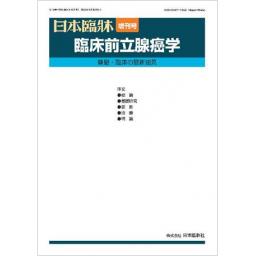1) Gutman AB, Gutman EB:An "Acid" Phosphatase Occurring in the Serum of Patients with Metastasizing Carcinoma of the Prostate Gland. J Clin Invest 17:473-478, 1938.
2) Huggins C, Hodges CV:Studies on Prostatic Cancer. I. The Effect of Castration, of Estrogen and of Androgen Injection on Serum Phosphatases in Metastatic Carcinoma of the Prostate. Cancer res 1:293-297, 1941.
3) Huggins C, Stevens RE Jr, Hodges CV:Studies on Prostatic Cancer:II. the Effects of Castration on Advanced Carcinoma of the Prostate Gland. Arch of Surg 43:209-223, 1941.
4) Huggins C, Scott WW, Hodges CV:Studies on Prostatic Cancer. III. The Effects of Fever, of Desoxycorticosterone and of Estrogen on Clinical Patients with Metastatic Carcinoma of the Prostate. Urol 46:997-1006, 1941.
5) Davies AH, Zoubeidi A:Targeting androgen receptor signaling:a historical perspective. Endocr Relat Cancer 28:T11-T18, 2021.
6) White JW:I. The Results of Double Castration in Hypertrophy of the Prostate. Ann Surg 22:1-80, 1895.
7) Huggins C, Stevens RA:The Effect of Castration on Benign Hypertrophy of the Prostate in Men. Urol 43:705-714, 1940.
8) Huggins C, Dao TL:Adrenalectomy and oophorectomy in treatment of advanced carcinoma of the breast. J Am Med Assoc 151:1388-1394, 1953.
9) Huggins C, Scott WW:Bilateral Adrenalectomy in Prostatic Cancer:Clinical Features and Urinary Excretion of 17-Ketosteroids and Estrogen. Ann Surg 122:1031-1041, 1945.
10) Byar DP:Treatment of prostatic cancer:studies by the Veterans Administration cooperative urological research group. Bull N Y Acad Med 48:751-766, 1972.
11) Schally AV, Arimura A, Bowers CY, et al:Purification of hypothalamic releasing hormones of human origin. J Clin Endocrinol Metab 31:291-300, 1970.
12) 松尾寿之:ストックホルムへの道-内分泌学におけるGuillemin, Schallyの先陣争い. 科学 48:537-547, 1978.
13) Schally AV, Arimura A, Kastin AJ, et al:Gonadotropin-releasing hormone:one polypeptide regulates secretion of luteinizing and follicle-stimulating hormones. Science 173:1036-1038, 1971.
14) Guillemin R, Burgus R:The hormones of the hypothalamus. Sci Am 227:24-33, 1972.
15) Sandow J, Von Rechenberg W, Jerzabek G, et al:Pituitary gonadotropin inhibition by a highly active analog of luteinizing hormone-releasing hormone. Fertil Steril 30:205-209, 1978.
16) Klotz L, Boccon-Gibod L, Shore ND, et al:The efficacy and safety of degarelix:a 12-month, comparative, randomized, open-label, parallel-group phase III study in patients with prostate cancer. BJU Int 102:1531-1538, 2008.
17) Toft D, Gorski J:A receptor molecule for estrogens:isolation from the rat uterus and preliminary characterization. Proc Natl Acad Sci U S A 55:1574-1581, 1966.
18) Mainwaring WI:A soluble androgen receptor in the cytoplasm of rat prostate. J Endocrinol 45:531-541, 1969.
19) Fang S, Anderson KM, Liao S:Receptor proteins for androgens. On the role of specific proteins in selective retention of 17-beta-hydroxy-5-alpha-androstan-3-one by rat ventral prostate in vivo and in vitro. J Biol Chem 244:6584-6595, 1969.
20) Baulieu EE, Jung I:A prostatic cytosol receptor. Biochem Biophys Res Commun 38:599-606, 1970.
21) Bruchovsky N, Wilson JD:The intranuclear binding of testosterone and 5-alpha-androstan-17-beta-ol-3-one by rat prostate. J Biol Chem 243:5953-5960, 1968.
22) Baulieu EE, Lasnizki I, Robel P:Metabolism of testosterone and action of metabolites on prostate glands grown in organ culture. Nature 219:1155-1156, 1968.
23) Shimazaki J, Kurihara H, Ito Y, et al:Testosterone metabolism in prostate; formation of androstan-17-beta-ol-3-one and androst-4-ene-3, 17-dione, and inhibitory effect of natural and synthetic estrogens. Gunma J Med Sci 14:313-325, 1965.
24) 鈴木和浩, 新井誠二:前立腺癌に対する内分泌療法:歴史と概論. 臨床泌尿器科 69:330-333, 2015.
25) Pavone-Macaluso M, de Voogt HJ, Viggiano G, et al:Comparison of diethylstilbestrol, cyproterone acetate and medroxyprogesterone acetate in the treatment of advanced prostatic cancer:final analysis of a randomized phase III trial of the European Organization for Research on Treatment of Cancer Urological Group. J Urol 136:624-631, 1986.
26) 志田圭三, 島崎 淳, 浦野悦郎, ほか:アンドロゲンの前立腺に対する作用機序に関する研究(第III編)合成ゲスターゲン剤の抗アンドロゲン効果(附)Chlormadinone acetateによる前立腺肥大症治験. 日本泌尿器科学会雑誌 63:109-128, 1972.
27) 志田圭三, 辻 一郎, 島崎 淳, ほか:前立腺癌に対する酢酸クロルマジノンの臨床効果. 泌尿器科紀要 26:1553-1574, 1980.
28) Tran C, Ouk S, Clegg NJ, et al:Development of a second-generation antiandrogen for treatment of advanced prostate cancer. Science 324:787-790, 2009.
29) Potter GA, Barrie SE, Jarman M, et al:Novel steroidal inhibitors of human cytochrome P45017 alpha(17 alpha-hydroxylase-C17,20-lyase):potential agents for the treatment of prostatic cancer. J Med Chem 38:2463-2471, 1995.
30) Aggarwal R, Huang J, Alumkal JJ, et al:Clinical and Genomic Characterization of Treatment-Emergent Small-Cell Neuroendocrine Prostate Cancer:A Multi-institutional Prospective Study. J Clin Oncol 36:2492-2503, 2018.
